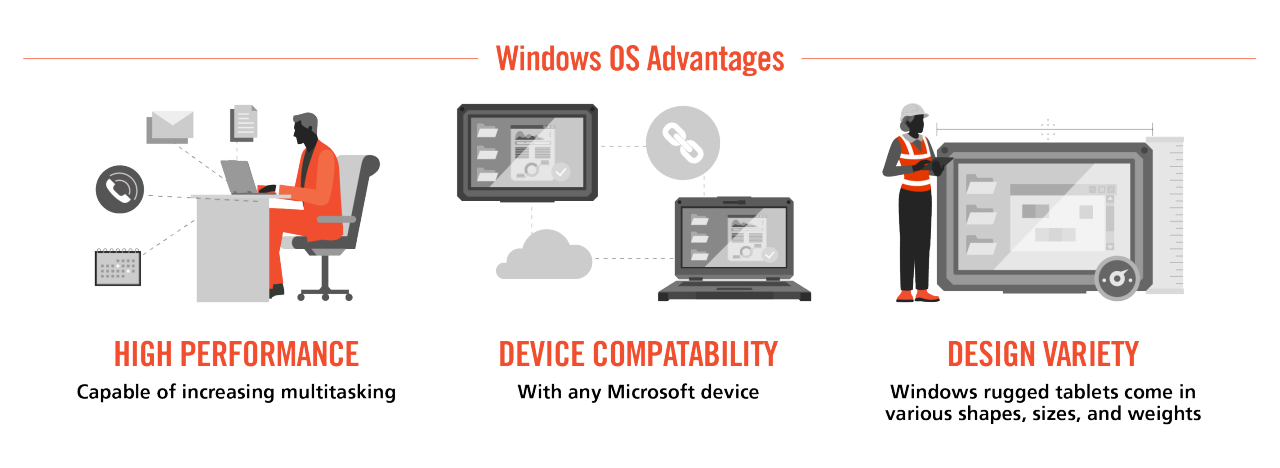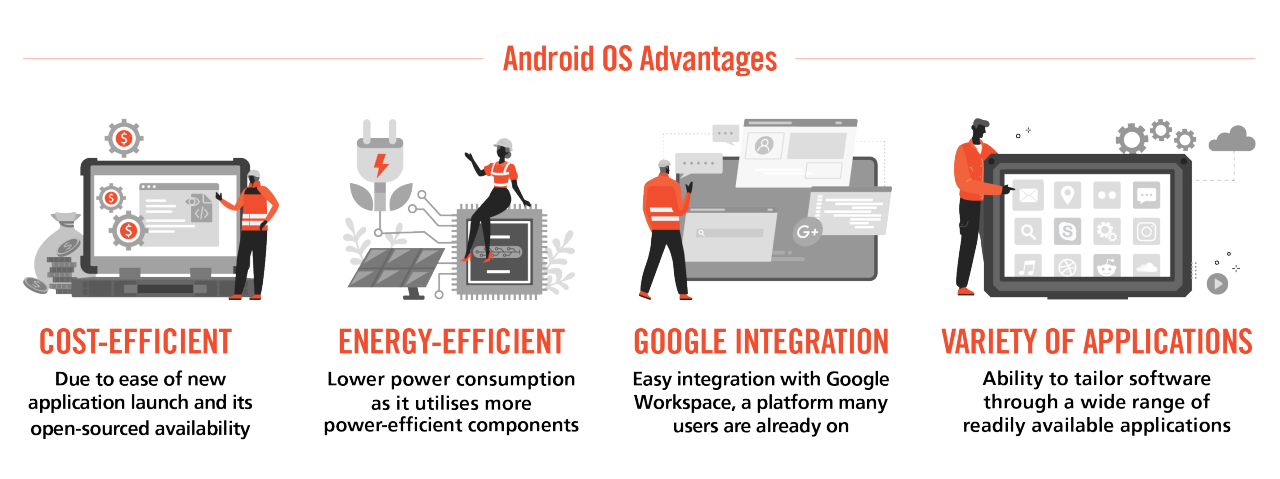As one of the leading rugged computer providers, Getac offers extensive rugged computing product lines and serves a wide range of vertical markets.

Getac Select
A combination of rugged computing devices, software, accessories and professional services in a purposeful range of specifically tailored solutions.
Getac Assist
Getac Assist is our fully rugged remote expert solution aimed at assisting field service engineers and technicians with knowledge transfer, remote guidance, inspection, quality control, safety, compliance, and more.
Defence
Mission-critical COTS computing that delivers high powered processing and reliability in operational environments.
Public Safety
Ambulance, Fire & Rescue and Policing applications
Utilities
Smart Meter Reading and Installation, On-site Safety, Utility Asset Management, Workforce Management for Utilities, Mobile GIS, Surveying and Mapping
Transportation & Logistics
Railroad Management, Airport Management, Port Management, Long-haul Delivery Fleet Management, Warehouse Materials Handling
Oil & Gas
Remote Support, Asset Management, Field Data Analysis, Workplace Safety
Industrial Manufacturing
Industrial Programming and Robotic Control, Facility management, Compliance and Inspections, Workforce Management, Inventory and Warehouse Management, Factory Automation and Plant Monitoring, EAM and CMMS Solutions.
Automotive
Optimised Rugged Mobile Solutions to drive a smarter approach throughout the automotive value-chain.
Natural Resources
Mining, Forestry and Construction applications
No matter the industry, all businesses have become connected. Technology solutions must be durable enough to withstand temperatures ranging from weather, drops, and impacts for applications in harsh conditions. For remote applications like a construction job site, a rugged tablet offers a technology solution that is portable enough to carry and hold while operating and durable enough to withstand the application's demands.
It is essential to select the application's correct operating system (OS) to maximise the benefits of using rugged tablets, considering the various features and benefits of different operating systems. The various operating systems carry similar but different features and benefits. As a result, the use case demands dictate which OS operators should use to provide optimal performance in the field. Of the commercially available OS options, the two most common are Windows and Android. After reviewing their advantages, this article will describe preferred applications for each OS and select the appropriate choice.
The operating system (OS) is the backbone of a tablet computer, playing a crucial role in its performance, functionality, and overall user experience. It manages hardware resources, provides a platform for running applications, and ensures data security. A reliable OS is essential for tablets, ensuring seamless operation in various environments. When choosing an OS for a tablet, it's vital to consider factors such as compatibility, reliability, security, performance, and ruggedness to ensure the best fit for specific needs.
Tablet operating systems have evolved significantly, with various options available for different needs and preferences. The most popular tablet OS options include Windows, Android, and iOS. Each OS has its strengths and weaknesses; the choice ultimately depends on the intended use, personal preferences, and specific requirements. For instance, Windows tablets are ideal for productivity and gaming, while Android tablets offer flexibility and customisation options. iOS tablets, on the other hand, are known for their ease of use and seamless integration with other Apple devices.
For years, Windows was the primary operating system choice. With the rise of the internet, many systems employed Windows as the first mainstream OS and never looked back. Numerous benefits have made Windows the standard OS, especially when compared to mobile devices like tablets and smartphones.
Windows-running rugged tablet computers are high-performing and capable of increasing multitasking, an increasingly essential trait of a tablet used in the field. A tablet running Windows 11 OS requires a 1GHz processor and 4GB of RAM to ensure it can run any application it receives. In addition, the Windows OS is robust enough to handle applications with comparable loads to gaming and intelligent video conferencing.
The wide usage of Windows makes integration an essential feature of a Windows-running tablet. When comparing Android vs. Windows tablets, Windows models offer many options for integration with third-party keyboards and mice, docking stations, hard drives, and other hardware components. In addition, Windows tablets typically contain multiple USB 3.0 and C ports and HDMI for connecting devices and presenting equipment.
In addition, a rugged Windows tablet can come in various sizes, shapes, and weights. Screen sizes can range from 7-15.6", allowing the user to select the optimal size for the application. This design flexibility enables users to choose the Windows tablet that best fits the usage scenario for their job.

The Android OS is an effective alternative that allows businesses to tailor the technical complexity to their needs. Many tablets ran on a proprietary operating system in the early days before transitioning to more widely adopted platforms like Android and Windows. Customisation is Android's most significant advantage, and there is a low barrier to publishing new applications without a lengthy review process. This advantage may be due to the Google Play Store being more popular than the Microsoft Store.
Although Windows tablets enjoy a robust, mature OS capable of performing nearly any task, users may not always need such a powerful system. This is because the processor, graphics, and RAM are always present, whether or not the operator uses their full capability. Some vendors create customised versions of Android with their own app store, allowing them to offer unique content and user experiences. Android OS can be application-specific, promoting a customised architecture that reduces overall hardware costs. In addition, Android carries a significantly lower licence fee.
The combination of more flexible hardware options and reduced licence fees make the Android tablet a cost-effective solution, enabling developers to avoid platform-specific code specifications.
While Windows OS implemented changes to extend battery life, Android generally uses less power and is more energy-efficient than its Windows counterparts due to its ability to customise system architecture to its application. Lower power consumption reduces operating costs and extends the lifetime from a single battery charge during remote operation.
Android can integrate with Google Workspace easily, as it is a platform many users already use. Seamless integration can tie the Android rugged tablet to cloud storage and the most powerful search engine. Though the ease of new application launch and open-sourced availability make the OS easy to institute, security issues are common with streamlined or no limited reviews and open-sourcing. Though Android may be slightly more susceptible to viruses than Windows, it carries the advantage of employing expandable memory to grow with the application.
Android tablets provide access to many different applications, downloaded from Google Play, and can be used simultaneously. The wide variety of applications available on Android tablets has significantly influenced the tablet market, making them a popular choice among consumers. In addition, Android apps are readily available and allow you to tailor the software to fit your needs.
With advantages to Windows and Android OS, reviewing applications better suited for either OS is helpful.

When selecting an OS for a tablet, several factors come into play. These include industry-specific requirements, reliability and security, durability and ruggedness, and compatibility with other devices.
Different industries have unique requirements when it comes to tablet operating systems. For example, healthcare professionals may require an OS that meets strict security and compliance standards, while educators may need an OS that is easy to use and manage. Understanding the specific needs of your industry is crucial when choosing an OS.
Reliability and security are critical factors to consider when selecting an OS. A reliable OS ensures the tablet functions smoothly and efficiently, while a secure OS protects sensitive data from unauthorised access. Look for OS options that offer robust security features, such as encryption, secure boot mechanisms, and regular software updates.
Tablets are often used in harsh environments, making durability and ruggedness essential considerations. Look for OS options designed to withstand extreme temperatures, vibrations, and drops. A rugged OS can ensure the tablet functions optimally, even in challenging conditions.
In conclusion, choosing the right operating system for a tablet is a critical decision that requires careful consideration of various factors. By understanding the importance of the OS, exploring different options, and evaluating industry-specific requirements, reliability, security, durability, and ruggedness, you can make an informed decision that meets your specific needs and ensures optimal performance and functionality.
The easiest way to decide which operating system to select is to determine how to use the rugged tablet. The choice of operating system can significantly impact tablet sales, with trends showing varying preferences for Android and Windows tablets over the years. Android may be the better choice if the application requires a simple, cost-effective solution that allows you to customise it to a specific use case easily. The rugged Android tablet takes the simplicity of the smartphone and extends its applicability to a business-capable, efficient, cost-effective solution.
Windows is better for high performance and integrated with other systems and devices, prioritising data integrity, device-managed security, and flexibility in tablet design features. A rugged Windows tablet maintains the power, safety, and compatibility of a laptop while adding the agility and compactness of a tablet.
Android tablets are gaining favorability in the marketplace in applications that do not require the capability of a Windows solution. Industries employing this device include Defence, Public Safety, Utilities, Automotive, Oil & Gas, and Transportation & Logistics. Getac offers the ZX10 rugged tablet, which provides its users with the advantages described above. Here are the essential features of the ZX10:
The ZX10 operates on Android 11 OS, can last an entire work shift, and boasts the efficiency and intuitive operation users expect from an Android tablet. The tablet uses a Qualcomm Snapdragon 660 CPU, which incorporates more computationally intensive tasks without the power draw of Windows models. It also includes dual microphones and contains a dedicated GPS.
Getac engineered the ZX10 to withstand rugged conditions with power and versatility. It is certified to survive weather and element, water-jet, and extreme temperature (-20-145°F) exposure.
The ZX10 comes with a 4990mAh battery, a 65W AC wall adaptor, and a capacitive stylus with a tether.
Optional accessories include a 100W Type-C wall and 120W DC-DC vehicle adaptor, as well as an external dual bay primary battery charger. For transport, the ZX10 fits into a fabric carry bag. When using the tablet, it works in a 2- or 4-point harness for hands-free access.
The ZX10 can use an office dock for touchscreen use or a keyboard dock for conversion to a laptop-style experience for a monitor-style display. It also integrates with a rotating strap, kickstand, and multiple models of vehicle docks.
A 10.1" touchscreen display with an 8MP front/16MP rear camera captures high-quality images and videos. In addition, the display augments the transportability of a hand-held tablet, allowing it to be used as a remote laptop when docked.
Because of the ZX10's durability, Getac offers a 3-year warranty to cover accidental damage to the entire device in these harsh working environments. This benefit provides you the peace of mind that you will be back running in days, minimising cost and downtime.
The ZX10 can be stored or used in environments between -60-160°F in 95% relative humidity (non-condensing) conditions.
Click here to explore Getac's rugged tablet solutions.
Android is a trademark of Google LLC. Windows is a trademark of the Microsoft group of companies
As one of the leading rugged computer providers, Getac offers extensive rugged computing product lines and serves a wide range of vertical markets.


